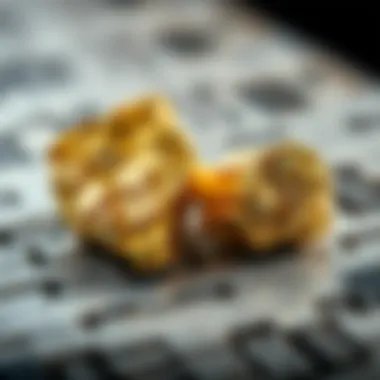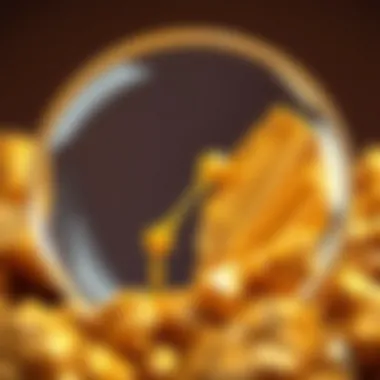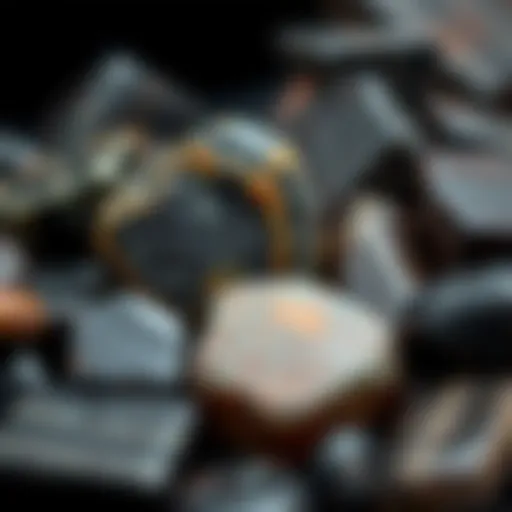Methods to Identify Genuine Gold Rocks


Intro
The allure of gold has fascinated humanity for centuries, much like moths to a flame. However, the line between authentic gold and deceitful imitations, such as pyrite, can be razor-thin. For rock and fossil collectors, the ability to determine the authenticity of gold rocks is crucial, not just for investment purposes but also for personal satisfaction and the thrill of discovery. This guide delves into the core aspects of identifying genuine gold from its look-alike counterparts, aiming to arm both novices and seasoned enthusiasts with the necessary knowledge to navigate the intricate world of rock collecting.
Overview of the Topic
When talking about gold rocks, it’s important to dissect the term into manageable pieces. The term generally refers to mineral specimens that contain significant amounts of gold, which are highly sought after. On the flip side, impostors like pyrite, often called "fool's gold," can easily fool the untrained eye due to their flashy appearance. With that said, understanding how to distinctly identify these minerals is key.
Definition of Key Terms
- Gold: A soft, yellow metal that is highly malleable and resistant to corrosion. Its chemical symbol is Au, and it has been associated with wealth and money for millennia.
- Pyrite: An iron sulfide mineral with a metallic luster, often mistaken for gold due to its bright yellow color yet lacking the same value.
- Specimen: A sample or collectible piece, often gathered for study or display.
Historical Significance
The quest to find gold has shaped societies, spurred explorations, and influenced economies across the globe. During the Gold Rushes, notably in the United States, large amounts of individuals descended upon gold-rich areas, driven by the hope of striking it rich. Collecting specimens became not just a hobby, but a way to preserve a piece of that rich history. Even today, educational institutions and museums are keen on keeping these artifacts pristine for future generations.
Types of Collectibles
Gold rocks can be classified into various categories, each holding distinct characteristics that can aid in their identification.
Classification of Different Collectibles
- Natural Gold Specimens: These are rocks containing naturally deposited gold. They can often display visible nuggets and veins.
- Gold Ore: This refers to rocks that host gold and other minerals, requiring further refinement.
- Mineral Associations: Specimens that showcase gold alongside other minerals like quartz.
- Pyrite: While not a gold specimen, it’s essential to recognize as a common mimic that enthusiasts may encounter.
Notable Categories
- Rare Formations: Some collectors seek out unique formations that include gold in unusual structures or mineral combinations.
- Historic Finds: Specimens that have a connection to famous mining districts or significant gold rushes can hold immense interest.
- Artistic Pieces: Certain collectibles are crafted or polished to highlight their natural beauty, resulting in a unique blend of art and geology.
As we move forward, we will explore tangible methods to differentiate between real gold and pyrite, along with practical tests to empower collectors in their pursuits. Understanding the bone structure of these rocks enables not just collection but also an engaging dialogue about natural history and human ambition.
Preface to Gold Rocks
Understanding what constitutes a gold rock is crucial for any enthusiast or collector. The importance of this topic stretches beyond mere curiosity; it serves as a foundation for identifying true gold in nature versus potential imitations or deceptive minerals. For anyone interested in geology or mineral collection, a firm grasp of what makes a genuine gold rock can prevent costly mistakes.
Understanding the Basics of Gold and Rocks
Gold has captivated human beings for millennia, and its appearance in nature has led to countless tales and legends. At its core, gold is a metal, a chemical element with the symbol Au, distinct for its luster and rarity. The rocks that host gold can vary immensely in characteristics and composition, complicating the identification process. Knowing the basic properties of gold helps collectors identify it among other minerals.
Gold comes in various forms; it can be found as nuggets or grains and often occurs in veins within quartz or other host rocks. Understanding these forms is essential because it informs how collectors should approach hunting for precious specimens.
When scouting for gold, one should look for indicators like quartz, iron staining, or other minerals that signal the presence of gold in surrounding rock.
Moreover, the rock's texture, hardness, and the overall geological environment contribute to its identification process. A nuanced understanding of the differences between gold and its imitators, such as pyrite, can vastly improve one’s chances of a successful find.
Historical Context of Gold in Nature
Gold's history is woven into the very fabric of cultures and economies around the world. Historically, it has symbolized wealth, power, and permanence. The ancient Egyptians, for example, mined gold abundantly, associating it with the divine. Their practices have heavily influenced today’s mining techniques, especially regarding ethical extraction methods.
Moreover, throughout history, large gold strikes, such as the California Gold Rush, sparked migrations and transformed entire landscapes. These not only allowed individuals to amass personal fortunes but also solidified gold’s position as a cornerstone of economic systems worldwide. The processes that brought gold to the surface are as varied as the cultures that have venerated it.
"Gold is the symbol of all that is pure and eternal in nature, yet it holds a volatile allure that has tempted folks for ages."
Today, when collectors approach a gold rock, they are looking not just for the metal itself but also for the stories that each specimen carries from long ago. This historical context not only satisfies curiosity but also enhances appreciation for the rocks one might encounter in nature. The value of gold rocks transcends their physical characteristics; thus, their story remains an integral piece of the larger puzzle.
Physical Characteristics of Gold
Identifying genuine gold rocks can feel akin to finding a needle in a haystack, especially when faced with impostors like pyrite. Therefore, understanding the physical characteristics of gold is crucial for collectors. Several specific attributes can help differentiate authentic gold from its lookalikes. By honing in on aspects such as color and luster, density and weight, and malleability and ductility, enthusiasts gain the tools necessary for effective identification.
Color and Luster
The first things that catch the eye when examining a rock are its color and luster. Real gold boasts a vivid yellow hue, glittering with a distinct, metallic sheen. This luster isn't merely a surface phenomenon; it's deeply embedded in the metal's atomic structure.


Notably, the color might vary slightly due to impurities or alloying with other metals. However, these variations often remain within the realm of a golden tint. Looking for this signature glimmer can be eye-opening.
In contrast, fool's gold displays a brassy yellow shade, often more dull and shiny than it should be. The texture of pyrite doesn't reflect light in the same way as real gold.
“When in doubt,* simply trust your eyes. The right color will eventually set off alarms for its wrong uncle.”
- For determining color and luster, consider:
- Metallic sheen: Is it smooth and bright?
- Consistency in color: Look for variation that’s still within the gold spectrum.
Density and Weight
Density serves as another critical factor when determining authenticity. Gold is remarkably dense, with a specific gravity of 19.3 g/cm³. This makes it heavier than many rocks that could resemble it. A good practice is to weigh your rock. If it feels lighter than expected, the chances are high that it's not real gold.
To measure density:
- Weigh the rock in grams.
- Submerge it in water and measure the volume of water displaced in milliliters.
- Apply the formula: Density = Mass/Volume.
If the density approximates 19.3 g/cm³, you could be onto something genuine. Keep in mind, though, if you’ve found a rock weighing similar to gold but not exhibiting the expected heft in hand, consider it a potential red flag.
Malleability and Ductility
Gold's magical properties extend into its malleability and ductility, which allow it to be hammered and stretched into fine sheets or thin wires without breaking. This is a crucial aspect when examining whether a rock is truly gold. You can gently tap your specimen with a hammer.
If it deforms easily and does not crack, it’s likely gold. Pyrite, on the other hand, breaks easily and shatters under pressure. Real gold can take quite a bit of punishment while retaining its shape, making it a true contender in the authenticity stakes.
So remember, testing for malleability can serve as the final nail in the coffin for fake gold assessments.
In summary, delving into the physical characteristics of gold is paramount for discerning the real from the faux. With a sharp eye, careful calculations, and a bit of hands-on examination, collectors can sidestep some common pitfalls when on the hunt for authentic specimens.
Distinguishing Real Gold from Fool's Gold
Identifying the true nature of a gold rock is essential for any collector. It's not just a matter of pride; it's about saving time and money. You don't want to waste your efforts on something that shines bright but holds little value. The difference between real gold and fool's gold—pyrite—is a classic challenge in the field of rock collecting. Understanding why this distinction matters is the first step towards becoming a well-informed collector.
Importance of Distinguishing Real Gold from Fool's Gold
Knowing the difference between these two substances can affect one's collecting strategy and the potential for investment. Genuine gold is a precious metal, sought after for its intrinsic value and aesthetic appeal. In contrast, pyrite, while visually similar, is relatively worthless and often leads unsuspecting collectors down the wrong path. Avoiding confusion not only saves collectors from disappointment but also enhances their knowledge and confidence in the field.
As the saying goes, "All that glitters is not gold." Recognizing this truth can lead to more authentic acquisitions and ultimately better investments. It paves the way for a more rewarding collecting experience.
Identifying Pyrite Characteristics
First things first, let's take a closer look at pyrite itself. Pyrite is typically yellowish-brass in color with a metallic luster. It's often found in cubic forms, which can be a giveaway. Unlike gold, pyrite is much harder; it won’t dent when struck. Sometimes it's challenging to tell at first glance, especially if a piece has a sparkling surface. However, if you stick to a few basic pyrite characteristics, you’ll find it easier to differentiate.
- Shape: Pyrite often forms in distinct cubes or octahedra. Real gold, on the other hand, don't have specific geometric shapes.
- Color: In natural light, pyrite will generally appear more brassy than gold’s warmer, deeper tones.
Be aware that some regions may produce mineral composites that can resemble both. Always examine multiple facets.
Visual Differentiators
Another engaging aspect of identifying gold versus fool's gold lies in the visual differentiators. Under the right light, real gold often reflects a warmer hue. Here are a few features you should scrutinize:
- Luster: Gold has a brighter, more lustrous shine compared to pyrite.
- Streak Test: When scraped against a surface, gold leaves a golden-yellow streak, while pyrite leaves a greenish-black streak. This fundamental test can save a lot of headaches.
Real gold tends to be more opaque, while pyrite sparkles more, which can make it easier to mistake it for gold at a quick glance. Keep an eye out for these details, and you might steer clear of that dealer trying to sell you shiny rocks.
Conducting Simple Scratch Tests
Scratch tests can be incredibly valuable—they're straightforward and can be done with minimal tools, yet they yield satisfactory results. Grab a piece of unglazed ceramic or even some concrete; these work wonders as test surfaces. Here’s how to proceed:
- Find a Testing Surface: Make sure it’s unglazed to reveal the true nature of your specimen.
- Conduct the Scratch: Lightly scratch the specimen against the surface. Be careful, as this will leave a mark.
- Observe the Streak: Note the color of the streak left behind. If it’s gold, it’ll leave a yellowish streak. If it’s pyrite, expect a darker hue.
Make sure to keep in mind that scratching can affect the rock, so don’t go too wild if it’s a prized piece. But for a quick and clear identification, this method can be a lifesaver.


In essence, understanding how to distinguish real gold from fool's gold is a valuable skill for any collector. Whether through identifying traits of pyrite, visual differences, or simple scratch tests, each method adds a layer of confidence to your collection efforts. Ensuring you're knowledgeable in these areas not only enhances your ability to collect but also deepens your appreciation for the beautiful complexities of nature.
Conducting Field Tests
Conducting field tests is a critical aspect when it comes to assessing the authenticity of gold rocks. These tests not only allow enthusiasts and collectors to gain hands-on experience but also provide immediate results in a natural setting. Understanding the significance of these tests helps in filtering out mere illusions—rocks that glitter but don’t hold the value of true gold.
Field tests offer multiple advantages:
- Immediate Feedback: Unlike sending samples off for lab analysis, field tests can yield quick results right on the spot, saving both time and effort.
- Cost-Effective: Many field tests require little to no financial investment, allowing amateurs and seasoned collectors alike to gauge the authenticity of their finds without breaking the bank.
- Practical Knowledge: Engaging in these assessments enhances one’s hands-on understanding of how gold behaves compared to imitations, a skill that sharpens over time.
However, conducting these tests comes with considerations. It is crucial to be aware that results can sometimes be inconclusive, as not all materials will react in predictable ways. Knowledge about the geological context and familiarity with other minerals present in the area can influence results significantly. Therefore, an informed approach is essential to avoid misleading conclusions.
Streak Test Basics
The streak test serves as one of the simplest and most effective methods for distinguishing gold from its imposters. The process involves rubbing the sample across an unglazed porcelain plate. The key is to observe the color of the streak left behind.
- Gold will leave a yellow streak—this is fairly definitive. On the other hand, pyrite and other minerals usually leave a greenish-black streak or a brownish one.
- This test can easily be performed outdoors, making it particularly suited for field evaluations.
It’s worth noting that while the streak test is reliable, the color can change with the alloy composition of the gold. If you have an item that you suspect might contain non-gold elements, ensure you take it into consideration.
Acid Tests and Their Application
Acid testing involves applying a small amount of acid to an inconspicuous area of the gold sample to observe the reaction. This method can give a good indication of whether the sample is indeed real gold or an imitation. Here’s a quick breakdown:
- Nitric Acid Test: When using nitric acid, pure gold will not react. However, if there’s a brisk fizz or bubbling, it’s a sign that you might be dealing with base metals or alloys.
- Gold Testing Solutions: Various kits are commercially available that combine different acid strengths specifically for testing gold.
While acid tests are efficient, they do carry risks. Always conduct this test in a well-ventilated area and handle acids with caution. An accidental spill can cause damage not just to the sample but also to your surroundings.
Using a Magnet to Test
One of the simpler checks you can perform is using a magnet to differentiate between gold and other metallic imposters like iron or nickel. Gold is not magnetic; therefore, a sample that sticks to a magnet is most likely not pure gold. However, this test must be approached with an understanding of its limitations.
- False Positives: Some metals that might seem attractive, such as certain types of alloys, can also be non-magnetic. So this test doesn't serve as a definitive means of authentication by itself.
- Combining Tests: Using a magnet alongside different techniques can provide a greater level of confidence in your findings. Combining the magnet test with the streak or acid tests potentially minimizes errors in identification.
"The beauty of using field tests is that they create layering in knowledge, each test supporting the credibility of the other, leading to better-informed decisions."
Expert Evaluations
In the realm of gold rock identification, expert evaluations stand as a cornerstone of authenticity assurance. The variance among gold specimens, whether genuine or not, can be surprisingly intricate. With countless imitations on the market, having the insight of an expert can mean the difference between a prized find and a worthless imitation.
When pursuing authenticity, appraisal encompasses various methodologies that professionals apply. These can include physical exams, advanced testing technologies, and the geological context of the specimen. Each method offers a plethora of benefits and considerations. For one, accuracy tends to be paramount. An expert's trained eye can often detect subtleties that the average collector might overlook. Additionally, the credibility of an appraisal might enhance the potential resale value of a specimen. Hence, investing in expert evaluations can afford peace of mind and possibly greater financial return.
Understanding Appraisal Methodologies
Every expert employs varied methodologies to assess gold rocks. Understanding these methodologies is essential for collectors hoping to determine if their specimens are the real deal.
- Visual Assessment: Initially, experts scour the surface for signs of wear, color discrepancies, and luster. This initial step is often the litmus test for authenticity.
- Weight and Density Tests: The specific gravity of gold stands at approximately 19.3, which is markedly higher than many impostors. Collectors should know that even subtle differences in density can hint at a fake.
- Spectroscopy: A highly sophisticated technique, using a spectrometer can reveal the elemental composition of a sample. This method is gaining traction amongst professionals for its precision.
- XRF Analysis: X-ray fluorescence is a non-destructive way to analyze the materials in the rock. This tool can provide insight into metal contents, determining the likelihood that gold is present.
Seeking Professional Assay Services
Engaging professional assay services is another layer of security for enthusiasts intent on verifying the authenticity of their gold rocks. An assay offers a detailed examination and provides documentation that confirms the gold's purity and quality.
- Choosing a Reputable Assayer: Start by seeking firms known for strong credentials and reviews in the geological community. Checking affiliations and certifications can be a wise move.
- Understanding Pricing Structures: Some assay services may charge based on the complexity of the analysis, while others might have fixed pricing. Understanding this can help in budgeting appropriately.
- What to Expect: Upon sending in a specimen, collectors will receive a comprehensive report detailing the analysis, which can be invaluable for future sales or trades.
"The value of a rock isn't merely what glows under sunlight; it often lies hidden within layers of geological history and professional insight."
Through these assessments and services, enthusiasts not only educate themselves further but also elevate their standing in collector communities. This symbiotic relationship between collectors and experts ultimately aids in shining the light on genuine gold rocks amidst the shadows of deception.
The Role of Geology in Identification
Geology plays a pivotal role in the discernment of authentic gold rocks. Understanding the geological context can offer critical insights that streamline the identification process. In rock collecting, each specimen has a story rooted in the earth’s processes, and this background can often illuminate authenticity or give clues about potential fakes. Recognizing the geological environment where gold deposits typically form can aid collectors in distinguishing real gold from its less valuable counterparts.
Geological Context of Gold Deposits


Gold is rarely found in isolation; it is usually accompanied by a suite of minerals formed under specific geological conditions. Primarily, gold deposits are categorized into two types: placer and lode.
- Placer Deposits: These are formed from the weathering of rocks, where gold particles are eroded and transported by water. Often, you'll find them in riverbeds or beach sands.
- Lode Deposits: These represent the original source of the gold. They are found within rocks, typically in quartz veins or associated with sulfide minerals.
Understanding these contexts helps collectors not only to identify potential sites for gold hunting but also to understand what other minerals may be present alongside gold. Notably, many of these minerals can offer additional indicators of genuine gold deposits when the familiarity with relative densities and appearances is established.
"A rock's origin can tell you more about its authenticity than the rock itself might reveal."
Understanding Mineral Associations
Knowing which minerals are typically found alongside gold is vital in telling fact from fiction. Some common mineral associates include quartz, pyrite, and arsenopyrite. These associations shape the appearance and characteristics of gold rocks. For instance, real gold can sometimes be intergrown with pyrite, which is often the cause for confusion between the two. Pyrite has a brassy sheen and a different hardness compared to gold. Recognizing its properties can save a collector from costly mistakes.
In terms of mineral associations to watch for:
- Quartz: Often found with gold, this mineral can take various forms that help in identification.
- Tellurides: These are minerals composed of tellurium and might indicate gold's proximity.
- Sulfide minerals such as pyrite can point to potential lode deposits and thus be relevant for the field tests.
To really arm oneself with knowledge, collectors should consider conducting a bit of field research on known gold-rich areas - looking into local geology provides a wealth of information that can elevate their understanding and support their identification efforts.
In summary, the geological context and mineral associations not only enrich the collector's knowledge base but also play an essential role in authenticating gold rocks, making the geology of an area a vital companion in the hunt for truly golden specimens.
Common Misconceptions
Understanding the world of gold rocks is sprinkled with myths and misunderstandings. It’s crucial to disentangle these to clearly appreciate what’s genuine and what isn’t. Misconceptions can lead collectors down the winding path of deception, making it hard to distinguish real gold from less worthy materials. By addressing these misunderstandings, enthusiasts—be they newcomers or seasoned pros—can enhance their rock-collecting journey and bolster their knowledge.
Debunking Myths Around Gold Rocks
One might think that all shiny, yellow rocks are gold. But alas, this is where the trap lies; not all that glitters is gold, so to speak. Among the myriad of stories you may have heard, the most prevalent myth is that the color alone can determine authenticity. This just isn’t the case. Real gold retains a specific hue and luster, but it can sometimes be imitated by minerals like pyrite or brass.
Another keystones in the misconceptions is the belief that size equates to quality. Larger pieces of gold rocks may seem more appealing, yet it’s essential to recognize their authenticity rather than simply being entranced by size.
Here's a quick rundown of common myths:
- Shine Equals Gold: Some think a brilliant shine means it’s gold. Reality is, many metals can shine bright.
- Geological Location: Many assume gold is always found in mountainous regions. Yet, sedimentary processes can bring it to unusual places!
- Weight Guarantees Authenticity: A heavy rock doesn’t assure it’s real gold. Dense metals exist that aren’t gold at all.
Remember, each of these notions could steer you completely in the wrong direction. As careful collectors, spotting these fallacies helps us separate the wheat from the chaff.
Clarifying Terminology in Rock Collecting
When embarking on your gold rock journey, it’s equally important to grasp the terminology used in rock collecting. Terms like ‘native gold’ or ‘ore’ often pop up, but not all collectors know precisely what they entail.
- Native Gold: This refers specifically to metallic gold, often found in its natural state. Knowing this helps when examining rocks in the field.
- Gold Ore: This is a broader term for any mineral from which gold can be extracted. Just because a rock is considered ore doesn’t mean it contains visible gold!
Misunderstanding these terms can create a foggy lens through which one views potential acquisitions. It can heighten expectations unreasonably or cause stalwart collectors to overlook legitimate gold specimens.
By clarifying the lingo, rock enthusiasts can engage more effectively with fellow collectors. Also, it aids in communicating findings accurately on platforms like reddit or facebook groups dedicated to collecting.
"An informed collector is a successful collector. Knowing what terms mean can be the difference between a prized piece and a mere stumble in the dusty road of rock hunting."
Recognizing the nuances in terminology not only enriches one’s understanding but also elevates discussions among peers in this niche community. Understanding misconceptions and the right terminology ultimately enhance your collection and enjoyment in the world of gold rocks.
Culmination and Key Takeaways
Understanding how to authenticate gold rocks is not just an endeavor suited for experts—it's an essential skill for anyone interested in rock collecting. The journey to pinpoint genuine gold from its deceptive counterparts, particularly pyrite, encompasses a range of techniques and insights that can profoundly influence one’s collecting experience.
Summarizing Identification Techniques
As we have explored, several methods stand out when it comes to identifying authentic gold. Here are key techniques to remember:
- Visual Inspection: Look for distinct coloration and shiny luster. Real gold has a rich yellow hue, while fool's gold appears more brass-like and dull.
- Streak Test: When scratched against an unglazed tile, real gold will leave a golden streak, while pyrite leaves a greenish-black streak.
- Density Checks: Gold’s density is significant, about 19.3 grams per cubic centimeter. If a specimen feels unusually lightweight for its size, it might be fake.
- Scratch Tests: The hardness of gold is another differentiator. A simple scratch test can reveal whether you’ve got true gold on your hands.
These methods, threading through the layers of geology and chemistry, present a well-rounded toolkit for enthusiasts.
Advice for Enthusiasts and Collectors
To navigate the world of rock collecting effectively, here are some practical pieces of advice:
- Educate Yourself: Dive into geology literature or engage with online forums, such as Reddit’s rock collecting community. Knowledge is a powerful ally in this realm.
- Network with Others: Connect with seasoned collectors on platforms like Facebook. The experiences and discussions can provide clarity and help you avoid pitfalls.
- Document Your Finds: Keep a detailed log of your specimens. Not only does this promote accountability, but it also helps you learn over time.
- Consider Professional Help: If in doubt, don’t shy away from seeking expert evaluations. An appraisal from a qualified expert can reveal information you might not have noticed.
In essence, the thrill of collecting gold rocks lies not only in the fascinating specimens themselves but also in the knowledge and community that surrounds them. By employing the techniques and heeding the advice discussed, collectors can navigate the often tricky waters of authenticity with confidence and enthusiasm.















